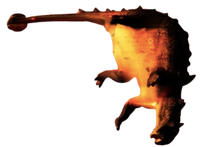
| Anteosaurus | |
|---|---|

| |
| Scientific classification | |
| Kingdom: | Animalia |
| Phylum: | Chordata |
| Suborder: | †Dinocephalia |
| Family: | †Anteosauridae |
Anteosaurus (meaning “Antaeus reptile”) is a genus of large carnivorous therapsids from Late Permian of South Africa. Like the well-known Moschops, they were dinocephalians, a clade of large-bodied therapsids that flourished from 270 to 260 million years ago and then went extinct without descendants.
Description[]
Anteosaurus had a tall, narrow skull, which is 80 centimetres (31 in) long. It was perhaps the largest known carnivorous non-mammalian synapsid, estimated at 5–6 m (16–20 ft) in length and 500 to 600 kg (1,100 to 1,300 lb) in weight.[2][3]
The teeth are another identifying characteristic of Anteosaurus. The teeth on the roof of the mouth are enlarged and confined in a cluster near the outer tooth row. The "normal teeth" include the anterior, canine and cheek teeth. A prominent feature of the dinocephalians is the ledge on the anterior teeth. The canine teeth are big, and there are usually about ten cheek teeth present. The front of the mouth curves up due to the premaxillary bone of the upper jaw.
Classification[]
Anteosaurus is a genus of anteosaurids in which the postfrontal forms a boss of variable size overhanging the dorso-posterior border of the orbit.” On this basis he synonymised six of the seven genera named from the Tapinocephalus zone: Eccasaurus, Anteosaurus, Titanognathus, Dinosuchus, Micranteosaurus, and Pseudanteosaurus. Of these, he says, Dinosuchus and Titanognathus can safely be considered synonyms of Anteosaurus. Eccasaurus, with a holotype of which the cranial material consists of only few typical anteosaurid incisors, appears to be only determinable as to family.
Paleobiology[]
Anteosaurus is believed to have taken down prey by toppling them over with its thick skull, delivering a killing bite while the prey is still knocked over. It wasn't able to run particularly fast, but its speed was likely enough for it to keep up with the slow herbivores it preyed upon. The hard, bony boss on its skull would have also been used for intraspecific combat. Like many therapsids, Anteosaurus may have been endothermic.